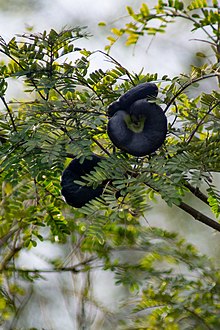Enterolobium barinense
| Enterolobium barinense | |
|---|---|
 | |
| Enterolobium barinense, nearly ripe pod of a wild tree in Villavicencio, Colombia | |
| Scientific classification | |
| Kingdom: | Plantae |
| Clade: | Tracheophytes |
| Clade: | Angiosperms |
| Clade: | Eudicots |
| Clade: | Rosids |
| Order: | Fabales |
| Family: | Fabaceae |
| Subfamily: | Caesalpinioideae |
| Clade: | Mimosoid clade |
| Genus: | Enterolobium |
| Species: | E. barinense |
| Binomial name | |
| Enterolobium barinense L.Cárdenas & H.Rodr.-Carr. | |
Enterolobium barinense, commonly known as caro blanco or oreja de negro, is a species of flowering tree in the pea family, Fabaceae. It was previously thought to be endemic to Venezuela,[1] but it has been located in neighboring Colombia as well.[2] It differs from the very similar and sympatric E. cyclocarpum by its black (instead of reddish-brown) and smoother pods, and by its larger, fewer and more rounded leaflets.
References
[edit]- ^ Barneby, Rupert C. (1996). "Silk tree, guanacaste, monkey's earring: a generic system of the synandrous Mimosaceae of the Americas. Part I. Abarema, Albizia, and allies". Memoirs of the New York Botanical Garden. 74 (1).
- ^ Mijares, F.J.; Aymard, G.A.; Pérez-Buitrago, N. (2018). "Nuevos registros para la flora vascular de Colombia presentes en la Orinoquia y reseña histórica de las expediciones botánicas a la región". Biota Colombiana. 18 (2): 72–87.


 French
French Deutsch
Deutsch